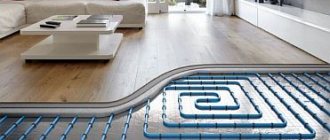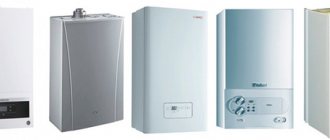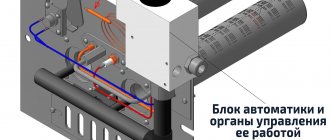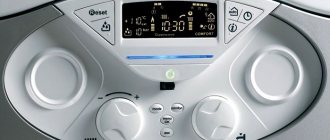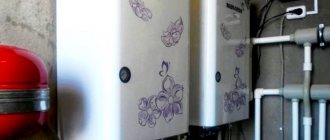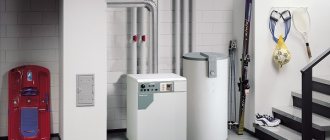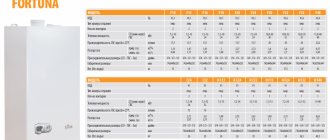Today, gas heating is still the cheapest. Therefore, if there is a main gas pipeline and technical capabilities nearby, it makes sense to install a double-circuit gas boiler. Why dual circuit? Because one device will provide both heat and hot water.
The wall-mounted double-circuit gas boiler has the dimensions of a small cabinet
When choosing a double-circuit boiler, be sure to pay attention to several parameters:
- installation method: floor-wall;
- power;
- type of combustion chamber (open, closed);
- type of heat exchanger and material from which it is made;
- set of service functions.
There are many other points, but these are the main ones. Without them, it is impossible to choose a double-circuit gas boiler; we will talk about them further. First of all, let’s get acquainted with the structure of this equipment and the principle of its operation. Then all the stages of choosing a gas boiler for a house, apartment or cottage will be clear.
Floor-standing gas boiler and storage boiler nearby
Structure and main differences
A gas boiler consists of three main modules - a burner, a heat exchanger, and automatic control. The burner is located in the combustion chamber, above it there is a heat exchanger in which the coolant is heated. The entire process is controlled by automation. It ensures safety and changes the operating modes of the equipment.
Boiler with a closed combustion chamber (turbocharged)
Types of heat exchangers
A double-circuit boiler is distinguished by the fact that it can heat both water for heating and water supply. This must be done separately, because special heat exchangers are needed. There are two types:
- Double heat exchanger. It consists of two separate modules - primary and plate. In the primary, the coolant from the heating system is heated, in the secondary - plate - water for domestic needs. The primary heat exchanger is a tube with fins, the secondary is a set of plates. They are located in different parts of the boiler - primary at the top, plate at the bottom, but they are connected to each other so they can be read as a single part.
- Bithermal heat exchanger. It consists of two metal tubes of different diameters inserted into one another. In the inner tube, water is heated for hot water supply, in the outer tube - for the heating system.
The structure of a double-circuit gas boiler.
A system with a dual heat exchanger is more reliable. Since heating is a closed system and the coolant circulates in a circle, little scale is formed. When heating water for hot water supply, the situation is the opposite - running water heats up, which means there is a lot of scale. This part of the heat exchanger periodically requires repair or replacement. If in a dual heat exchanger it is possible to replace only the part that heats water for domestic needs, then in a bithermal heat exchanger there is no separation; you have to change the entire device, and this is much more expensive. There is one more point: a double-circuit gas boiler with a double heat exchanger works normally for heating, but with a bithermic the situation is different - it does not work at all.
Heat exchanger material
The choice of a double-circuit gas boiler can also be influenced by the material from which the heat exchanger is made. It could be:
- Stainless steel. A good option in terms of durability, but it has rather low heat transfer, which reduces the efficiency of the boiler. However, the price of such a heat exchanger is high.
- Cink Steel. This is the cheapest type of heat exchanger, but also the most short-lived.
- Copper. An excellent option for heat transfer (boilers have high efficiency) and durability, but the price is high. But this scares few people - it outweighs the opportunity to pay less for gas during operation. It is for this reason that most good double-circuit gas boilers are equipped with a copper heat exchanger.
This is what the primary heat exchanger looks like in gas wall-mounted boilers
Choosing a double-circuit gas boiler based on this parameter is not so difficult. Copper seems to be the best option. Not without its drawbacks - high chemical activity and low melting point - but they have long learned to compensate for them. The boiler automation ensures that there is no overheating. Chemical activity is neutralized by using chemically neutral materials in the heating system - using polymer pipes - polypropylene or cross-linked polyethylene.
Types of burners for gas boilers
In wall-mounted double-circuit gas boilers, atmospheric gas burners are installed. According to the method of controlling the flame, they are:
- Single stage. The burner either burns or it doesn’t. There are no intermediate provisions. To maintain the required heating mode, the burner either lights up or goes out. Not the best working algorithm.
- Two-stage. There are two operating modes - at 100% power and at 50-60%. The automation itself regulates the required power. Such burners are more economical and allow you to maintain the temperature more accurately. By reducing the number of on/off switches.
Double-circuit gas boiler with modulating burner is the most economical - Modulated. The most expensive type of burners, but also the most economical. It is controlled automatically, the power is set to what is needed at a given time from 10% to 100%. A double-circuit gas boiler with such a burner has a minimum of on/off cycles, which has a positive effect on durability. In addition, fuel consumption under equal conditions is 10-15% less.
If we talk about the optimal choice, then these are modulating burners. They not only allow you to maintain the heating temperature accurately, but also heat the water exactly to the specified parameters. If you want to choose an economical double-circuit gas boiler, it must have a modulating burner.
Automation
Automation is a must in gas boilers - it ensures safety and switches operating modes. There are three main parameters that are constantly monitored:
- presence of draft in the chimney;
- gas pressure;
- flame control.
These are key points that simply need to be monitored. If at least one of these parameters is not normal, the boiler does not turn on. In addition, there is an extensive list of additional functions:
- Maintaining a stable temperature. There are two types of automation: one controls the temperature of the coolant, the second controls the air in the room. More comfortable conditions are created by controlling the air - the weather changes, but regardless of this, the set mode is maintained in the room.
This is the remote control from which all parameters are set - Post-circulation mode. After the burner is turned off, the heat exchanger is at a very high temperature. If the circulation pump is turned off immediately, the water in the heat exchanger may boil, which will lead to its failure. To avoid this situation, the pump circulates the coolant for some time and turns off only when the temperature becomes acceptable.
- Anti-frost. If a double-circuit gas boiler is located in a country house where you live only periodically, you can set the economy mode. The boiler will maintain a stable temperature of +5°C. The same function can be used during departure.
- Summer mode. In summer, the heating does not turn on, the boiler only works to heat water. To prevent stagnation in the system at this time, so that the elements do not become clogged, the automation turns on the circulation of the coolant once a day for a while.
These are the functions that are common, but there are also specific ones: the ability to connect (and control) solar panels, underfloor heating systems. There is weather-compensating automatic control. In this case, there are remote sensors that are installed on the street. Based on their data, the operation of the boiler is adjusted.
Ferroli Diva gas boiler control panel
All these functions are embedded in the microprocessor, which controls everything. Of all the automation systems, the average user only encounters a remote thermostat, which can be installed in any room and based on the readings of which the temperature can be adjusted (another additional feature). Basically, all interaction with the boiler and its automation is limited to a small panel. All necessary information is displayed on the screen. There are also buttons with which you change modes and set the temperature.
Equipment traction options
During operation of the unit, fuel burns and flue gases are generated. To remove them from a living space, natural or forced draft is necessary. It will ensure timely removal of all combustion products and released harmful substances from the apartment or house.
Natural draft modules
Boilers operating on natural draft have a simple design and take the air necessary for proper combustion from the room in which they are located. During intensive use, a certain amount of steam and various chemicals are released. Emissions are removed through a vertical chimney.
Among the main advantages of units with natural draft are reasonable cost, energy independence and absence of noise effects during operation.
In general, devices with natural draft are convenient and good, however, when the pressure in the gas pipeline drops, the quality of their work decreases significantly. At the same time, the risk of rapid burnout of the burner increases, since the fire at a reduced pressure level dies out or goes inside the burner device.
Uneven pressure in the main networks provokes serious overconsumption of fuel, which entails an increase in the amount of utility bills.
Forced draft devices
Boilers with forced draft are sometimes called forced-air or fan-type. They take air not from the room where they are located, but from the street. The modules have closed combustion chambers, and waste substances are emitted through a coaxial horizontal outlet using a powerful fan built into the system.
A coaxial bend consists of two pipe elements of different diameters inserted into one another. Through the smaller pipe, combustion products exit the room, and through the space between the small and large pipes, fresh air enters the room from the street, which is necessary for the full functioning of the boiler
Products with forced draft are easy to install, do not make any demands on the location, do not “eat up” oxygen in residential premises, work stably and accurately even with reduced gas pressure in the central main networks and do not require the installation of an additional vertical chimney.
The devices are criticized for the noisy operation of fan elements, higher cost and dependence on power supply.
Principle of operation
A double-circuit gas boiler can operate in two modes - heating and water heating. The boiler itself has two circuits through which the coolant moves. One of them - with a primary heat exchanger - works for heating, the second - with a plate heat exchanger - for preparing hot water. Switching occurs using a three-way valve.
The exact operating mode of a double-circuit boiler is specified by the manufacturer, but usually the heating operating mechanism is as follows:
- When the room temperature drops below a certain level, the automation transmits a signal to turn on the circulation pump. The coolant begins to move, creating a vacuum in the return pipeline. At the same time the burner turns on.
- As the coolant flows through the heat exchanger, it heats up, spreading heat throughout the system.
- Running around the radiators, it cools down and returns to the boiler inlet at a lower temperature.
- It is heated again by passing through the heat exchanger.
- When the set temperature is reached (there is control by the coolant temperature, there is control by the room temperature), the burner turns off, the coolant circulates for some time, adjusted by the circulation pump (post-circulation mode). When the heat exchanger temperature drops to a certain level, the circulation pump stops. The boiler does not operate as long as the temperature is within normal limits. As soon as it becomes 1°C below the set limit, the boiler turns on again.
Different operating modes of double-circuit gas boilers
With some variations, this operating algorithm is repeated in different boilers. When heating water for domestic needs, everything happens approximately the same, only the signal to turn on the burner is the appearance of water flow in the circuit. That is, you open the hot water tap, the burner lights up. Only in this operating mode does the three-way valve switch and close the coolant inside the boiler. The hot coolant heats the secondary heat exchanger, and from it the running water is heated. Heating stops when the water overheats (when the threshold value is reached) or after the tap is closed. The burner goes out, the circulation pump runs until the heat exchanger cools down, then turns off.
Distinctive features of heat exchangers
The heat exchange unit of the heating device can be cast iron, steel or copper. The cast iron version retains heat for a long time, is almost not subject to corrosion due to the high wall thickness and is resistant to aggressive coolants. It is heavy and therefore mainly integrated into floor-standing boilers.
Requires great care during installation, since any impacts violate the structural integrity of the material and lead to the formation of microcracks.
The steel structure weighs little, is not afraid of mechanical stress, can easily withstand temperature changes in the coolant, and is easily transported and installed. Has some tendency to corrosion. The boiler control system helps to avoid it, which prevents the coolant temperature from falling below the critical point.
Copper elements are an order of magnitude more expensive than their cast iron and steel counterparts, but they compensate for the substantial cost with a large number of advantages. Inside the copper heat exchanger, sediment and scale are formed to a minimum and do not interfere with the normal circulation of the working fluid. The walls of the device are heated evenly and do not cause local overheating of the coolant.
Installation method
Depending on the installation method, gas boilers can be floor-mounted or wall-mounted. Wall-mounted - compact installations, the size of a small kitchen cabinet. They do not require equipment in a separate room and can be installed in the kitchen or other suitable room. The maximum power of a wall-mounted gas boiler is 30-35 kW. This is usually enough to heat rooms with a total area of 250-350 square meters. m.
Floor-standing gas boilers are more powerful and, accordingly, have larger sizes and weight. There are models that can be installed in a living space, while others require a dedicated room - a boiler room. Installation requirements are prescribed by each manufacturer separately, but usually the distance from the top of the boiler to the ceiling, the volume of the room and the presence of ventilation are specified.
Wall-mounted gas boilers are larger in size and weight, but this is due to their higher power
Regardless of the type, a certified project is required to install gas boilers. The diagram must include a gas meter, so if it is not there, you will need to purchase one. Connection work must be carried out by a company that has a license for this type of activity. Only in this case will the boiler be put into operation.
Selecting a double-circuit gas boiler based on installation method is simple. If there is enough power, they usually take a wall-mounted version, if not, a floor-mounted one.
Design features of the unit
A household gas appliance consists of a housing, two communication circuits, a built-in burner, a heat exchanger, an expansion tank, a combustion product exhaust unit, a gas valve and a control unit.
The main circuit is connected to the common heating system in a closed circuit. When the unit is actively operating in heating mode, the coolant circulates through the primary circuit pipes, but does not enter the hot water supply (DHW) communication system, since the path there is blocked by a special valve.
When installing equipment with two circuit elements, you must remember that the length of the communication pipe connecting the boiler to the farthest point of water intake should not exceed 7 meters. Otherwise, mineral elements deposited in the form of scale in the heat exchanger area will begin to interfere with the movement of the working fluid and the productivity of the water heater will significantly decrease
When the user turns on a hot tap in the kitchen or bathroom, the valve is activated, closes the entrance to the heating pipes and directs the coolant to the DHW circuit to warm up the water in the heat exchanger.
From there, the liquid enters the tap and is used for its intended purpose. When there is no longer a need for hot water and the tap is closed, a reverse switch occurs and the valve again redirects the coolant to the heating circuit.
Combustion chamber type
The gas burner is located in the combustion chamber. There are two types - open (atmospheric) and closed (with a turbine, forced). A double-circuit gas boiler with an open combustion chamber can only be installed in rooms with good ventilation. During operation, the oxygen necessary for combustion is taken from the room, and combustion products are discharged into the chimney with good draft. Therefore, a good air flow and a properly functioning exhaust ventilation duct are necessary.
Gas boilers come with open and closed combustion chambers
Gas boilers with a closed combustion chamber are distinguished by the fact that at the chamber outlet there is a coaxial chimney (pipe within a pipe) equipped with a fan. The chimney is taken out into the street, or into the wall near the boiler. Through one pipe, air is taken in from the street, through the second, combustion products are removed, their movement is ensured by a fan-turbine.
Which combustion chamber is better? A boiler with a closed combustion chamber operates more stably - air enters directly into the combustion zone. But there is also a disadvantage to this: with a side wind, the air flow can be so strong that it blows out the burner and the boiler turns off. The second disadvantage of this solution is freezing and the formation of ice in winter. Well, the third drawback is that such a boiler only works when there is electricity - without a turbine it turns off. Well, there is another small minus - the turbine is not silent. It’s almost inaudible, but it’s “almost.” Apparently for these reasons, if possible (a working ventilation duct), boilers with an open combustion chamber are installed. After all, ensuring a constant flow of air is much easier.
The best condensing dual-circuit models 2022
Protherm Lynx 25/30 MKV
The Slovak-made condensing model is capable of heating up to 212 m2 and produces approximately 14.2 liters of hot water per minute. This performance is quite enough to provide two water points - for example, a kitchen and a bathroom. There is a turbocharged closed combustion chamber here, so there will always be enough oxygen in the house (more precisely, the boiler will not burn it). Like the Ariston model, Lynx is equipped with a “hot start” function, which speeds up the heating of water in the water supply system. There is also a sensor installed here that switches the device to summer mode during the warm season. In this mode, the unit only works to heat water.
The efficiency of the device, thanks to the receipt of thermal energy from steam, is 104%, which is approximately 9% more than that of conventional convection models. The manufacturer has equipped the model with protection systems against freezing and water overheating. The first controls the temperature of the water in the heating pipes and, when it drops below 5° C, starts the boiler to avoid the formation of ice. The second turns off the device when the critical water temperature is reached. Overall, this is an excellent boiler for the money, which works one hundred percent.
BAXI Duo-Tec Compact 28
This unit is designed for a large house up to 224 m2. Its efficiency is slightly higher than the previous one and is 105.8%, which, compared to conventional convection ones, gives about 11% savings on gas. The second circuit is capable of heating up to 16.1 l/min of water, which is enough to operate a shower stall, washbasin and sink. A turbocharged combustion chamber and a forced smoke exhaust system will help maintain a comfortable atmosphere in the apartment. Both heat exchangers are made of stainless steel. Please note that the boiler design is equipped with an outside temperature sensor. It monitors the temperature outside the window and, in accordance with it, reduces or increases the power of the unit.
You can safely connect a heated floor to the device, since there is a powerful circulation pump. It allows you to effectively pump water through a circuit with high resistance. If the water circulation is disrupted, the device turns off the gas supply to the burner, as well as the pump itself, to avoid damage to these components. There are also systems installed here to protect against freezing and overheating of water in the pipes.
Bosch Condens GC7000iW
This model in the Bosch line of condensing boilers is one of the most economical. It can operate on both natural and liquefied gas. Its efficiency is as much as 108% - this is 13 - 15% better than convection devices. When you connect the Easy Control control panel, you can control the device via the Internet. This is very convenient, since you can receive a report on the operation of the boiler or generated errors even while at work. The unit can work with both water and antifreeze specified in the passport documentation for the device.
The design of the device is equipped with a 5th generation aluminosilicate heat exchanger with a matrix burner. There is also a 12 liter expansion tank. The maximum productivity of hot water at a temperature of 30 ° C is about 12 l/min - this is enough for two water points. A pressure gauge is installed on the front panel to visually determine the operating pressure. This is a high-quality, durable German-made boiler for heating and hot water supply. But as you know, you have to pay for quality, and this truth is confirmed by the rather high price of this unit.
Some more useful tips for organizing heating in your home:
Voltage stabilizer for a gas boiler: which one to buy for your home?
Heating cables for water supply: which one is better?
Boiler power
One of the key points in choosing a heating boiler is determining the required power. If we approach this with full responsibility, it is necessary to consider the heat loss of each room, if we are talking about an apartment or a building as a whole, if the boiler is selected for heating a private house. The calculations take into account the materials of the walls, their thickness, the area of windows and doors, the degree of their insulation, the presence/absence of an unheated room below/above, the type of roof and roofing material. Geographical location and a whole bunch of other factors are taken into account.
Such a calculation can be ordered from a specialized organization (at least in GorGaz or a design bureau), if desired, you can do it yourself, or you can take the path of least resistance - calculate based on average standards.
Where does the heat leave the house?
Based on the results of all calculations, a standard was derived: heating 10 square meters of area requires 1 kW of heating power. This standard is suitable for rooms with ceilings of 2.5 m, with walls with an average degree of thermal insulation. If your room falls into this category, divide the total area that needs to be heated by 10. You get the required boiler power. Then you can make adjustments - increase or decrease the resulting figure depending on real conditions. It is necessary to increase the power of the heating boiler in the following cases:
- The walls are made of material with high thermal conductivity and are not insulated. Brick and concrete fall into this category for sure, the rest - depending on the circumstances. If you are choosing a boiler for an apartment, you need to add power if the apartment is corner. For “internal” ones, heat loss through them is not so terrible.
- The windows have a large area and do not provide airtightness (old wooden frames).
- If the ceilings in the room are higher than 2.7 m.
- If in a private house the attic is not heated and poorly insulated.
- If the apartment is on the first or last floor.
The design power is reduced if the walls, roof, and floor are well insulated and energy-saving double-glazed windows are installed on the windows. The resulting figure will be the required boiler power. When searching for a suitable model, make sure that the maximum power of the unit is not less than your figure.
How to choose and what to pay attention to?
- Control method : single stage. two-stage or three-stage. Two-stage boilers adapt best to daily and seasonal temperature changes.
- Heat exchanger type : separate or bithermic devices. Separate ones have 2 heat exchangers: one for heating, the second for hot water supply. In such boilers, scale does not form and boiling of water is eliminated, but they are more expensive. Bithermic ones have double elements, the disadvantages are worse cross-country ability and scale formation.
- Automation : mechanical or electronic. Electronic ones are more expensive, but in case of problems with electronics, additional repair costs are required.
With or without boiler
We will talk about how water is heated. A conventional double-circuit gas boiler acts as an instantaneous water heater. Hot water is often needed not constantly, but in small portions, which leads to frequent switching on/off of the boiler. This mode leads to rapid wear of the equipment, but it is too expensive to turn off the water. The solution to this problem is a double-circuit gas boiler with a boiler.
Connecting an indirect heating boiler to a double-circuit gas boiler
A boiler gas boiler has a small built-in storage tank in which a certain supply of heated water is stored. When the hot water tap opens, flow comes from the tank; when the supply comes to an end, the burner turns on and continues to heat the water. After the tap is closed, the boiler continues to work for some time, filling the boiler, then turns off. This mode of operation leads to less wear and tear on the equipment. The disadvantage of gas boilers with built-in boilers is their large size, because you still need to place the boiler somewhere. There are models with a remote boiler, then the tank is connected to the boiler, and can be installed on the floor of the boiler or next to it.
Reviews of domestic wall-mounted models with a DHW circuit: advantages and disadvantages
| Advantages | Flaws |
| Favorable price - double-circuit models are only 10-15% more expensive than single-circuit models, so this is the cheapest way to organize hot water supply in the house, compared to installing a gas water heater, electric boiler, etc. | Higher probability of failure - double-circuit models can operate without problems for 10 years or more, but statistically the probability of failure is higher compared to single-circuit ones, due to their more complex design and additional features. nodes |
| Compactness - double-circuit boilers only in rare cases differ in size from the same single-circuit analogues from the same manufacturer | Relatively long delay in the supply of hot water - can be solved by more expensive models with a built-in boiler |
| Simplicity of connection - a minimum of communications connected to one point, in contrast to the installation of separate devices for heating water | Limitation in productivity - on average, the DHW productivity of common modern models is within 8-12 l/min, which is enough for a maximum of three, and according to owner reviews, often only for two points of simultaneous consumption |
| Availability of relatively inexpensive models with a built-in storage tank, solving problems of comfort and, to some extent, performance | Energy dependence - all heating gas wall-mounted double-circuit boilers require connection to the electrical network, despite high demand, non-volatile models do not exist due to the specific design |
| Restrictions on the use of antifreeze - most models are not designed to use antifreeze as a coolant, and only some manufacturers allow the use of a certain brand of liquid, as indicated in the operating instructions |
Double-circuit gas boilers: manufacturers
Having decided on the technical characteristics, all that remains is to find a suitable model and choose a manufacturer. This is not at all easy - there are many companies on the market, prices vary considerably. As usual, there are three segments - expensive, mid-priced and cheap.
Expensive ones are products from European manufacturers:
- Italian gas boilers - Ferroli, Beretta, Ariston, Baxi.
- The German ones are not inferior to them in quality: Viessmann (Weissmann), Wolf (Wolf), Vaillant (Vialant).
- Korean Navien (Navien) are worthy competition to the leaders.
This equipment works reliably and without failures, but only under certain conditions. The first is a stable power supply, without significant deviations in frequency and voltage. Our networks lack stability, so a voltage stabilizer is needed, preferably an electronic one. The second condition for normal operation is a certain gas pressure in the line. Most German and Italian gas boilers operate if the gas pressure is 2 atm or more. The exception is the Ariston and Navien boilers.
Manufacturers of double-circuit gas boilers number in the dozens
Russian-made wall-mounted double-circuit gas boilers - Danko, Protherm - have proven themselves well on the market. They have approximately the same functionality as the “Europeans”, but react less sharply to deviations in the power supply and operate at low gas pressure. What is not pleasing is the Russian “service”.
There are also Bosch boilers. The company itself is German, but there are factories in Russia, so it’s not easy to determine the geographical location of these boilers - some are produced in Russia, some at other factories in other countries. Bosh campaign specialists have developed a new boiler model adapted to our conditions - Gaz 6000 W.
comparison table
When choosing a gas boiler for an apartment or house, you should first of all proceed from its technical characteristics. You can compare them using our table.
| Model | Thermal power, W | Efficiency, % | Expansion tank volume, l | Natural gas consumption, cubic meters/hour | Average price, rub. |
| Navien DELUXE 13K | 7–13 | 91,7 | 6 | 1,4 | 31 774 |
| Buderus Logamax U072-12K | 5,4–12 | 92 | 8 | 2,1 | 36 995 |
| Bosch Gaz 6000 W WBN 6000-18 C | 5,4–18 | 93 | 2,1 | 35 065 | |
| BAXI ECO-4s 24F | 9,3–24 | 92,9 | 6 | 2,73 | 36 339 |
| Lemax PRIME-V20 | 9–20 | 92,5 | 2,27 | 35 857 | |
| Viessmann Vitopend 100-W A1JB010 | 24 | 91 | 2,77 | 39 227 | |
| Vaillant turboFIT VUW 242/5-2 | 9,7–23,7 | 93,5 | 7 | 2,66 | 39 828 |
| Ariston CARES X 24 FF NG | 11–25,8 | 93,7 | 8 | 2 | 38 025 |
| Protherm Cheetah 23 MTV | 9–24,6 | 93,2 | 5 | 2,9 | 41 568 |
| WARM AUROS KA11224 | 9.50-24 | 94 | 6 | 2.83 | 54 890 |
| BAXI LUNA-3 240 Fi | 9,3–25 | 92,9 | 8 | 2,84 | 67 526 |
Strapping scheme
Dimensions to be observed during installation
Before piping a wall-mounted heating boiler with your own hands, the boiler owner must choose where to install the heater.
Construction standards MDS 41-2.2000 clearly regulate the dimensions and location of:
- for an apartment up to 60 kW - in the kitchen or room with an external wall;
- in an external extension to the house;
- in a separate boiler room building.
There are size requirements, the total volume of which must ensure the ratio: 15 m3 + 0.2 m3 per 1 kW of gas pumping unit.
For example, to install 10 kW you will need a kitchen with a volume of 10 + 10 x 0.2 = 12 m3. For ventilation, at least a window and a door supply grille with a flow area of more than 0.025 m2 must be installed.
The manufacturer recommends observing the following intervals when installing the HDNK.
Visual wiring diagram
Connection diagram:
- Boiler.
- Coolant supply tap.
- DHW system tap.
- Chimney with coaxial pipes and pipe fittings.
- Security devices and sensors.
- Device for collecting dirt.
- Expansion tank of membrane type.
- Shut-off and control valves.
- Cast iron heating radiators.
- Supply and return pipelines of the heating system.
- DHW supply and return pipeline.
- Shut-off valves.
- The point of insertion into the water supply, it is better to connect with polypropylene.
In this boiler installation scheme, the water purification filter is installed at the drinking water entry point into the house. DHNK structurally cannot provide an intensive load of hot water supply, so it is quite enough to connect 2-3 hot water supply points.


